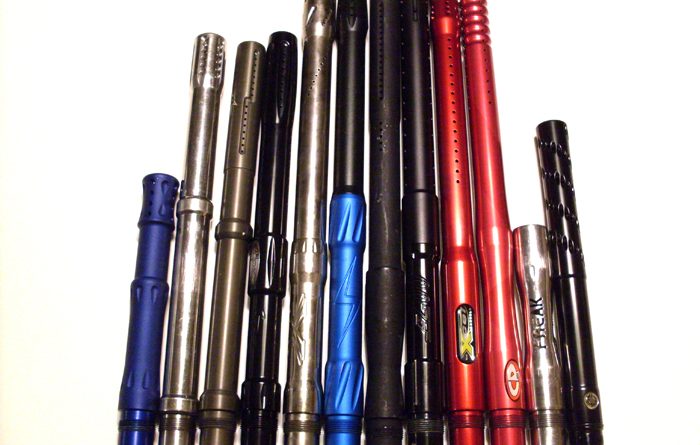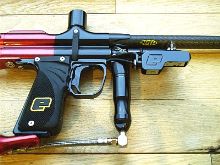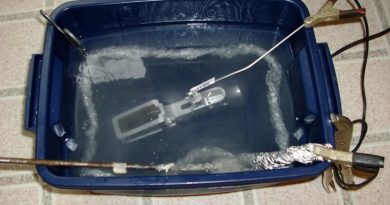Paintball Barrel Myths
By Tyler Titus
There are a lot of different barrels out there, I see questions like what barrel is the most accurate? Which one is quietest? Which one is better for woods?
First you need understand what makes a good barrel.
Length is a common misconception. People think that a longer barrel will be more accurate, that is not correct. Longer barrels help on firearms because the longer the barrel the higher the velocity (FPS) the bullet travels. In paintball no matter what the barrel length we adjust the velocity to 300 FPS (feet per second). For a good paintball barrel length you just need enough length for the gas to expand and get the ball going 300 fps. Ideal length is 8-12 inches. Anything over around 12 inches will make a drop in your FPS (compared to a 8-12 inch barrel) and require you to turn your velocity up (requiring more air). A longer barrel also increases the chances of a ball breaking in the barrel. A barrel shorter than around 8 inches will require more gas also because by the time the ball leaves the barrel the gas wont have had enough time to expand behind it, this requires you to turn up your velocity (using more air). It also increases the chances of breaking a ball because you have to have more air hitting the ball at once to make up for the lack of time for the gas to expand in the barrel so the initial harder “smack” could break balls. What else besides length matters?
You want the inside of the barrel to be as smooth as possible so the ball has the least friction possible. You need to make sure that the ball will not spin. You don’t want round projectiles to spin. It also helps with gas efficiency because it takes less force to push the ball out of the barrel. You want the barrel to be perfectly straight also (not a factor with most newer barrels). Most polished aluminum then anodized barrels are very good, for example: Lapco Bigshots and All American barrels. Also some ceramic coated barrels are good, like the JJ ceramic barrel. There have been some barrels made out of brass, but the only barrel, to my knowledge, still being produced is by Palmer’s pursuit shop.
I have not tested it but It’s reportedly a very good barrel. It uses a tapered bore, the bore starts off the size of the paintball at the beginning then towards the middle of the barrel the bore tapers to a larger diameter, then back to the normal diameter at the end of the barrel. There’s some speculation of how the bore helps with the accuracy of the barrel, but from many peoples words, the barrel is very accurate.
Porting also plays a serious role in barrel accuracy. Porting reduces the built up pressure in front of and behind of the ball right before it leaves the end of the barrel. This helps reduce any turbulence. If a 14 inch barrel is ported from the middle of the barrel to the end, the effective barrel length is only 7 inches, after the porting pressure behind the ball is lost, so the next 7 inches is just causing drag, which slows down the ball. Which means you will have to turn up your velocity (again using more air) to compensate. The only thing that this kind of porting does is make barrels quieter. The best place for porting is about 1-2 inches behind the end of the barrel, it uses the least gas but it makes the barrel louder (loudness maters to some people, not others, its all personal.
One last note, a few select barrels have been rifled. Rifled barrels have small grooves cut in them. There are two types of rifling; spiral rifling (like on real firearms) and straight rifling. Spiral rifling is completely pointless for paintball, it increases the chances of chopping. Further, spinning round liquid filled projectiles does nothing besides skew the trajectory and make it harder for the balls to travel straight.
Straight rifling is a straight grove down the inside of your barrel. I have a straight rifled barrel and it seems to work ok. Straight rifling might help to keep the ball from spinning but it hasn’t been proven. It might use a little more air than a normal barrel because some air could escape through the rifling but the slots aren’t that deep and don’t take up much volume.
What about flatlines you ask? They cause backspin which makes the ball rise at longer distances. It doesn’t help with accuracy. If you compare flatlines to a good normal barrel they are just as accurate or slightly less accurate. They just add range.
In closing, before you buy your next barrel, don’t base your decision on which is the most expensive, which is longest, or any of the other gimmicks some manufacturers use to bait you, take into account the true facts. Buy a simple straight, smooth, short barrel.




